
The Best Mulching Techniques for Cherry Trees: Tips for Healthy Growth and Protection
Mulching is one of the simplest yet most effective ways to boost the health and growth of your cherry trees. The Best Mulching Techniques for Cherry Trees can make a significant difference in their overall vitality, protecting them from extreme weather, conserving moisture, and even suppressing weeds. Whether you’re a seasoned gardener or just starting, understanding the right way to mulch your cherry trees is essential for ensuring they thrive. In this guide, we’ll explore the best mulching methods that promote strong roots, abundant fruit, and a healthier tree all year round.
Table of Contents
Toggle Why Mulching is Essential for Cherry Trees
Why Mulching is Essential for Cherry Trees
Mulching is a simple yet powerful practice that can significantly benefit your cherry trees. Here’s why:
- Moisture Retention
Mulch helps the soil retain moisture, ensuring your cherry tree has a steady water supply. This is especially important during hot, dry periods, reducing the risk of dehydration and stress on the tree.
- Temperature Regulation
Mulch acts as a natural insulator, keeping the soil temperature stable. It helps keep the roots cool in the summer and prevents freezing in the winter, which is crucial for healthy growth. - Weed Control
By covering the soil, mulch prevents weeds from taking root, which means less competition for nutrients and water. This ensures your cherry tree gets the resources it needs to thrive. - Soil Enrichment
As mulch decomposes, it enriches the soil with organic matter, improving its structure and fertility. This promotes better root growth and overall plant health. - Reduced Soil Erosion
Mulch helps prevent soil erosion by protecting the surface from heavy rain. It keeps the soil in place, ensuring your cherry tree has a stable foundation.
In summary, mulching is a must for healthy cherry trees. It conserves moisture, regulates temperature, controls weeds, enriches soil, and prevents erosion. Apply a 2-4 inch layer of mulch around the base to enjoy these benefits year-round!
 When to Mulch Your Cherry Trees
When to Mulch Your Cherry Trees
Mulching your cherry trees at the right time can make a big difference in their growth and overall health. Here’s when and how to mulch effectively:

The ideal time to mulch cherry trees is in early spring or late fall. In spring, mulch helps conserve moisture and regulate soil temperature as the weather warms. In fall, it provides insulation for the roots, protecting them during winter’s chill.
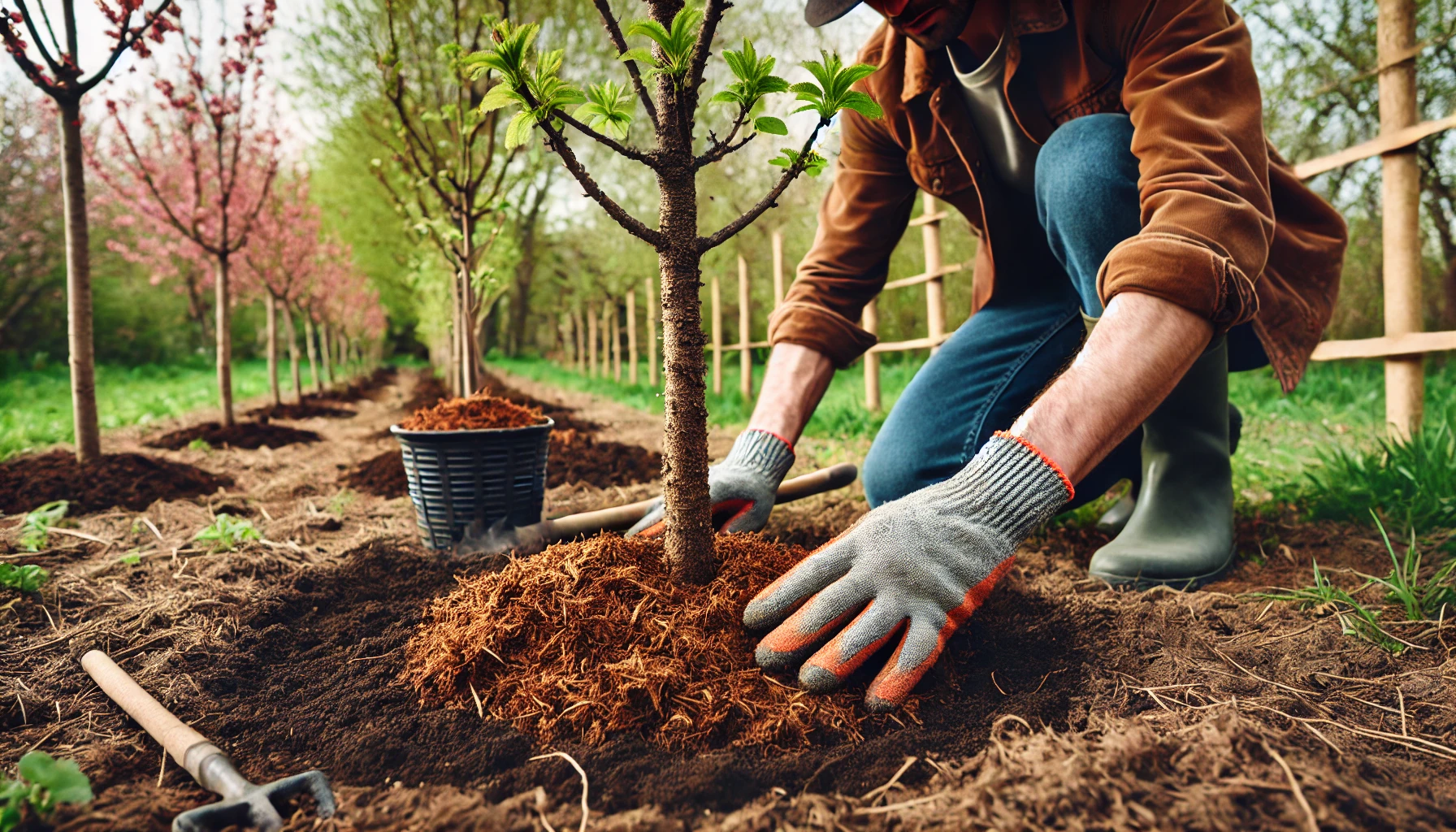

If you’re planting a new cherry tree, apply mulch immediately after planting. This will help retain moisture while the tree establishes its roots. Just make sure the mulch isn’t piled up against the tree trunk to avoid rot.

Once your cherry tree is established, a thin layer of mulch (about 2-3 inches) applied annually in spring or fall will help keep the soil moist, suppress weeds, and provide nutrients as it decomposes. Just remember to refresh it as needed.
Mulching at the right time ensures your cherry tree thrives throughout the seasons!

 The Best Mulch Materials for Cherry Trees
The Best Mulch Materials for Cherry Trees
Mulching is essential for cherry trees to thrive, as it helps retain moisture, suppresses weeds, and regulates soil temperature. Here’s a breakdown of the best mulch materials you can use for your cherry trees:
1. Wood Chips and Shredded Bark 
Wood chips are a top choice for cherry trees. They break down slowly, offering long-term benefits like moisture retention and soil enrichment. They also provide a natural look to your garden.
2. Straw or Hay 
Straw is lightweight, easy to apply, and great for maintaining soil moisture. It decomposes quickly, adding organic matter to the soil. Just make sure to avoid moldy hay to prevent fungal diseases.
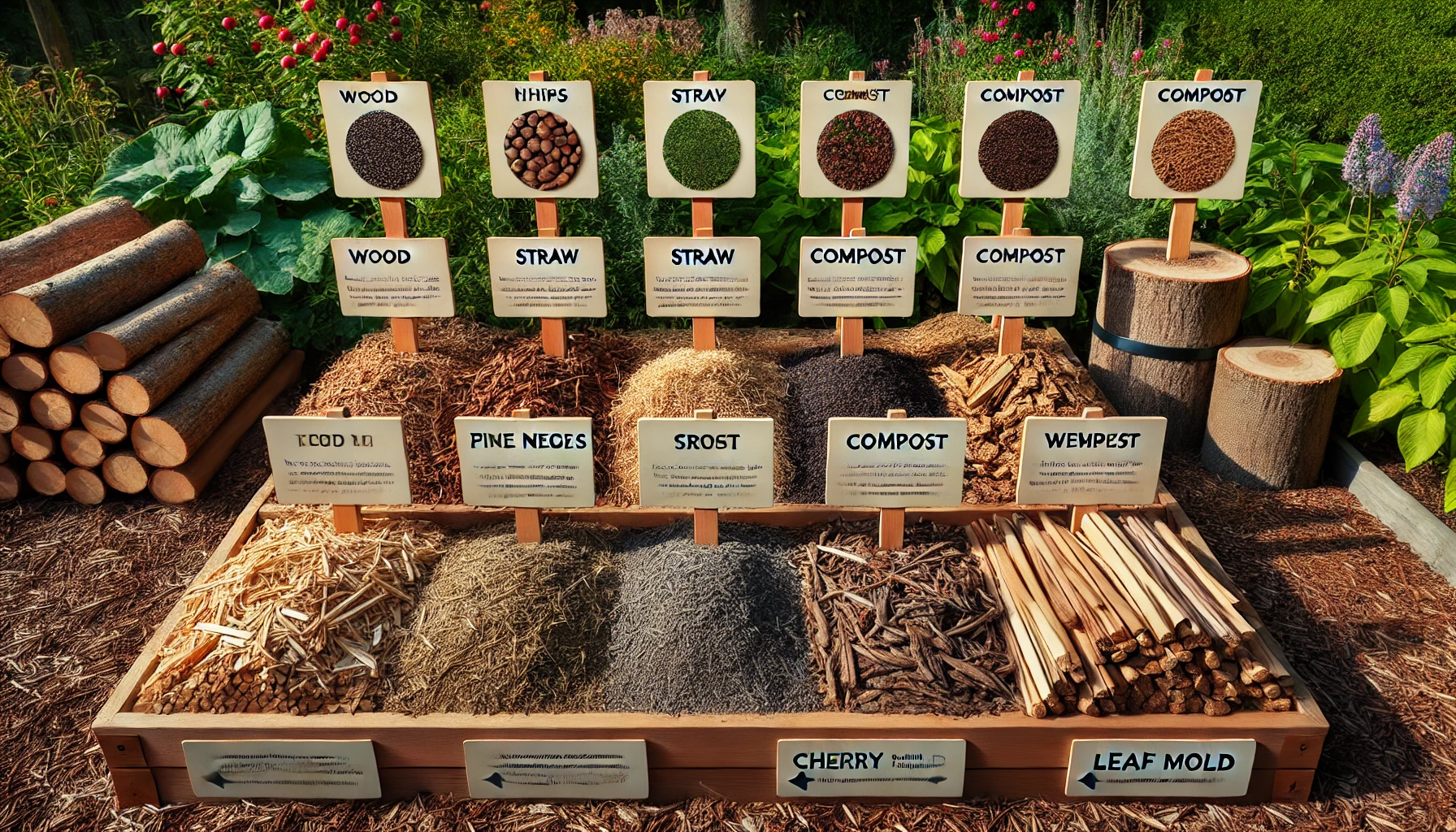
3. Compost 
Rich in nutrients, compost helps to improve the soil structure. It also provides a gentle, steady release of nutrients, promoting healthy growth in cherry trees. Just ensure it’s spread thinly to prevent excess moisture buildup.
4. Pine Needles 
Pine needles are a great mulch for cherry trees due to their ability to acidify the soil slightly, which can benefit certain varieties of cherry trees. They also allow good air circulation around the roots.
5. Leaf Mold 
Leaf mold is an excellent mulch for cherry trees, especially in the fall. It’s a natural soil conditioner, improving moisture retention and adding valuable nutrients.
Tips for Mulching Cherry Trees 
- Apply a 3-4 inch layer of mulch around the base of the tree, keeping it away from the trunk to avoid rot.
- Refresh mulch regularly to keep it effective.
- Avoid heavy, dense mulches like clay, which can suffocate the roots and lead to water drainage issues.
Choosing the right mulch material can make a huge difference in the health and productivity of your cherry tree. Happy mulching!
 How to Apply Mulch Properly
How to Apply Mulch Properly
Mulching is one of the easiest and most effective ways to keep your garden healthy. Here’s how you can apply mulch properly to reap the benefits:
- Choose the Right Mulch: Select a mulch that suits your plants. Organic mulches like wood chips or straw work well for most gardens. For flower beds, try a finely shredded mulch for a neat appearance.
- Prep the Soil: Before applying mulch, remove any weeds and lightly loosen the soil. This ensures better mulch-to-soil contact, promoting healthier plant growth.
- Apply the Right Thickness: Spread mulch 2-4 inches thick. Too little won’t provide adequate protection, and too much can suffocate your plants. Keep the mulch away from the plant stems to prevent rot.
- Water Before Mulching: Water the soil before applying mulch. This helps retain moisture and ensures your plants get the hydration they need.

- Reapply Annually: Mulch breaks down over time, so replenish it each year to maintain its benefits. This keeps your garden looking fresh and healthy year-round.
By following these simple steps, you’ll create a thriving garden with less effort, saving time on watering and weeding.
 Mulching for Disease Prevention and Pest Control
Mulching for Disease Prevention and Pest Control
Mulching is one of the most effective strategies for protecting your garden from diseases and pests. By covering the soil with organic materials like straw, wood chips, or leaves, you can create a barrier that offers multiple benefits for plant health.
Disease Prevention: Mulch helps to keep soil moisture consistent, preventing it from splashing onto plant leaves during rain or watering. This reduces the spread of soil-borne diseases like blight or fungal infections. By maintaining a dry surface, mulch also discourages the growth of harmful fungi and bacteria.

Pest Control: A thick layer of mulch can act as a natural deterrent to pests. For example, it discourages weeds that can host pests, and certain types, like cedar mulch, have insect-repelling properties. Mulch also provides shelter for beneficial insects, like earthworms, which help maintain a healthy soil ecosystem.
Tips for Best Results:
- Apply a 2-3 inch layer of mulch around the base of plants.
- Keep mulch away from plant stems to avoid rotting.
- Refresh mulch regularly to maintain its effectiveness.
Incorporating mulch into your garden care routine is an easy, natural way to reduce disease risk and keep pests at bay, promoting a healthier and more vibrant garden.
 How Much Mulch Is Too Much?
How Much Mulch Is Too Much?
When it comes to mulching, more isn’t always better! While mulch offers many benefits, like moisture retention and weed suppression, using too much can harm your plants.
Ideal Mulch Depth: Aim for a mulch layer that’s about 2-3 inches thick. This depth is perfect for most plants, allowing roots to breathe while still providing enough insulation and moisture.
Signs of Too Much Mulch:
- Root Suffocation: Thick layers can block airflow to the roots, leading to poor plant growth or even root rot.
- Moisture Issues: Too much mulch can trap moisture and create a soggy environment, promoting fungal growth.
- Pest Problems: A heavy mulch layer can attract pests like rodents and insects, as it provides them with shelter and food.
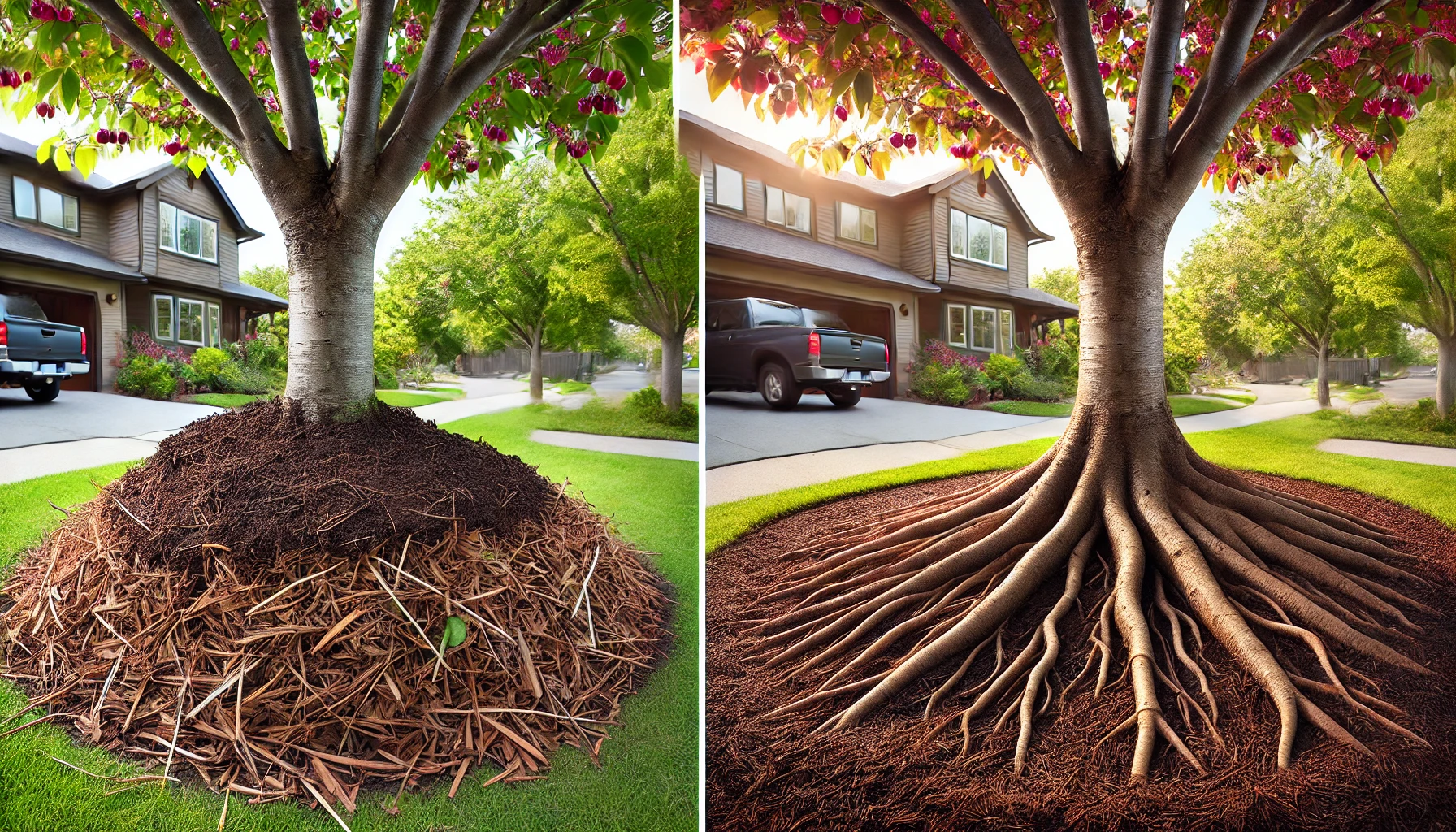
Mulch Placement Tips:
- Keep mulch a few inches away from the base of plants or tree trunks. This prevents moisture buildup and reduces the risk of rot.
- Mulch should be spread evenly to ensure proper drainage and root access to oxygen.
Mulching correctly enhances your garden’s health and beauty. Just remember, moderation is key!
 Maintaining Mulch and Monitoring Tree Health
Maintaining Mulch and Monitoring Tree Health
Mulch is essential for the health of your tree. It helps retain moisture, regulate soil temperature, and suppress weeds. Here’s how to maintain mulch and keep your tree healthy:
- Apply the Right Amount of Mulch: Use 2-4 inches of mulch around the base of your tree. Too much mulch can suffocate the roots, so avoid piling it up against the trunk. Leave a gap around the base for airflow.
- Replenish Mulch Regularly: Mulch decomposes over time. Reapply it annually to maintain its benefits, especially during dry months.
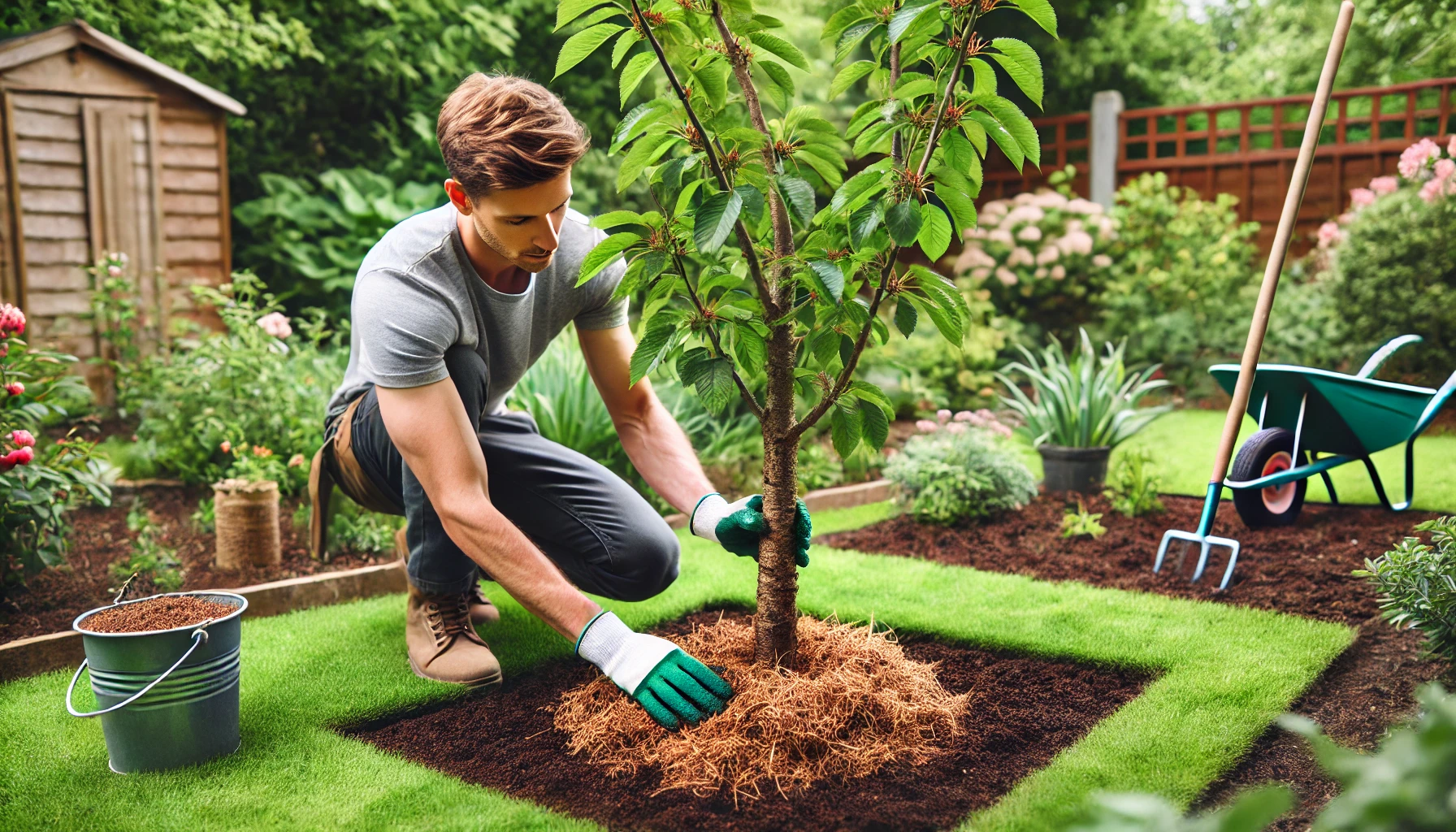
- Check for Compacting: As mulch settles, it may compact. Gently fluff it up with a rake to maintain its effectiveness.
- Monitor Tree Health: Regularly inspect your tree for signs of stress, such as yellowing leaves or abnormal growth. Look for pests and disease early to prevent damage.
- Water Properly: Mulch helps retain moisture, but it’s important to ensure the tree is watered deeply and consistently, especially during dry spells. Deep watering encourages strong root growth.
By keeping mulch in good condition and monitoring your tree’s health, you can ensure a thriving, long-lasting tree!
 Common Mulching Mistakes to Avoid
Common Mulching Mistakes to Avoid
Mulching is an essential part of garden care, but if done incorrectly, it can lead to problems for your plants. Here are some common mulching mistakes you should avoid to keep your garden thriving:
Too Much Mulch
Applying too much mulch can suffocate plant roots, preventing air and water from reaching them. Keep mulch layers around 2-3 inches deep for optimal growth.Piling Mulch Against Trunks or Stems
Mulch should never touch plant stems or tree trunks. Piling it up can trap moisture and cause rot or attract pests. Leave a small gap around the base of your plants.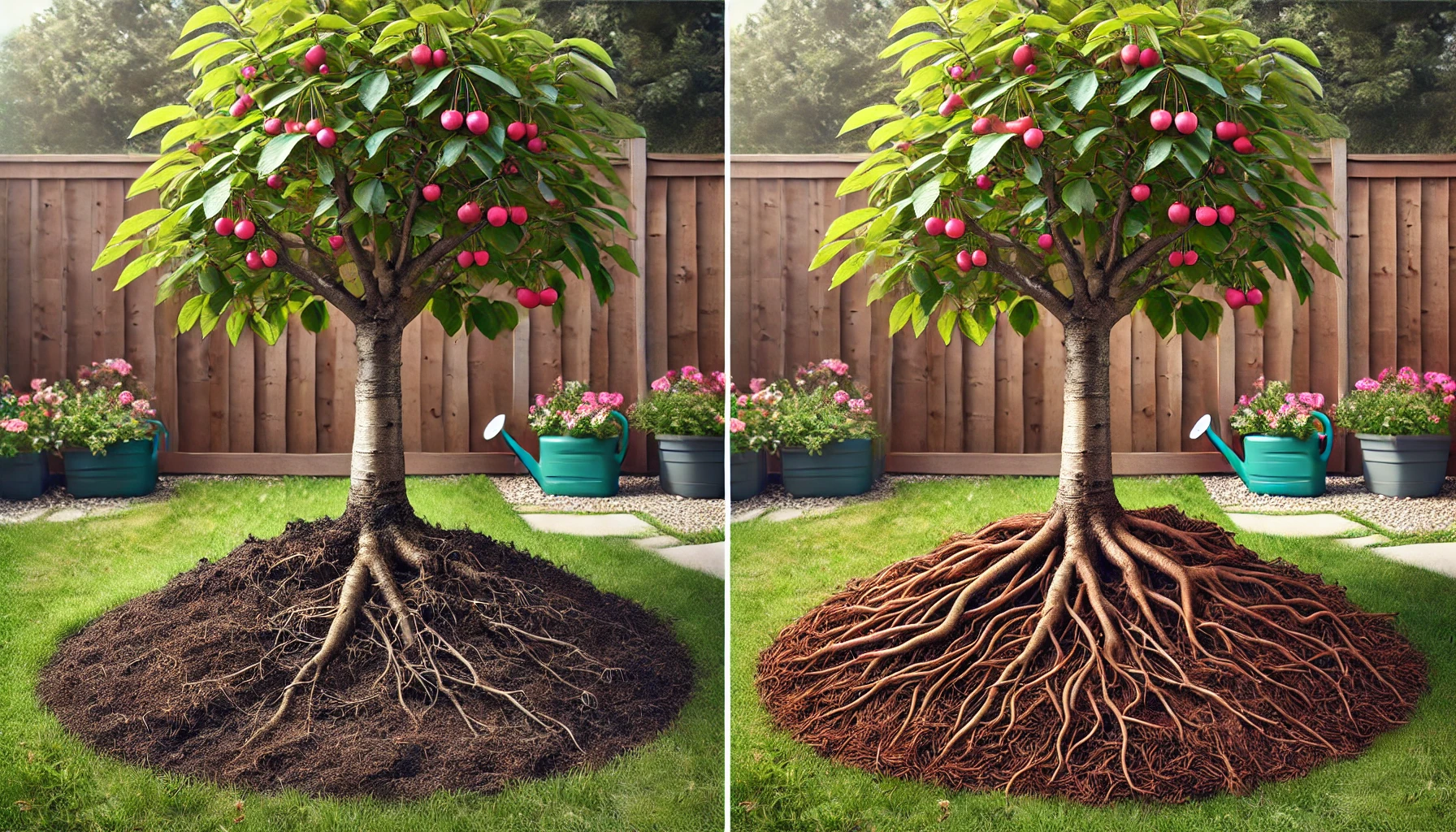
Using the Wrong Type of Mulch
Not all mulches are equal! Organic mulches like wood chips are great for moisture retention, while inorganic options like rubber can create heat and repel water. Choose a mulch that suits your garden’s needs.Neglecting Watering After Mulching
Mulch helps retain moisture, but it’s not a substitute for watering. Always water plants thoroughly after applying mulch to ensure the soil is properly hydrated.Mulching Too Early
Applying mulch too early can trap in cold temperatures, which may damage tender plants. Wait until the soil has warmed up in spring before mulching.Not Refreshing Mulch Regularly
Over time, mulch decomposes and loses its effectiveness. Refresh your mulch annually to maintain its benefits for your garden.
Avoid these mistakes, and your garden will reap the full benefits of mulching—healthy plants, better moisture retention, and less weeding!
 Conclusion
Conclusion
In conclusion, The Best Mulching Techniques for Cherry Trees are essential for promoting healthy growth, protecting your tree, and ensuring long-term success in your garden. By choosing the right mulch, applying it correctly, and maintaining it throughout the year, you provide your cherry trees with the moisture, temperature regulation, and pest protection they need to thrive.
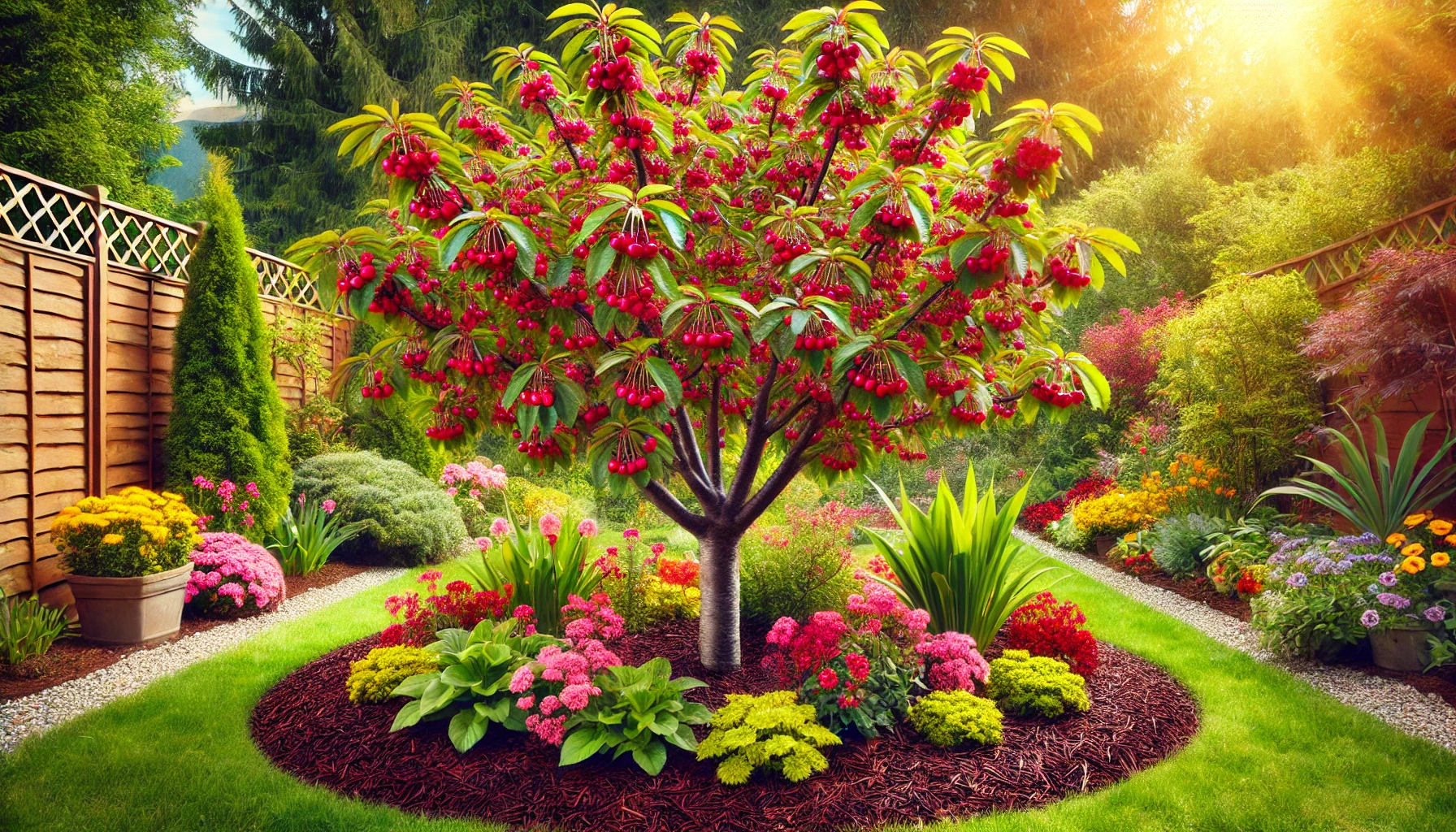
Remember, mulching is not just a one-time task—it’s an ongoing process that requires attention and care. By following these tips, you can enjoy vibrant, healthy cherry trees that produce beautiful fruit for years to come. 
Frequently Asked Questions(FAQ)
Why is mulching important for cherry trees?
Mulching helps cherry trees by retaining moisture, regulating soil temperature, and suppressing weeds. It also promotes healthy root development, improves soil structure, and protects the tree from environmental stresses. 🌱
When is the best time to mulch cherry trees?
The best times to mulch cherry trees are early spring and fall. In spring, mulching helps conserve moisture and protect roots from extreme heat, while in fall, it provides winter protection by insulating the soil. 🌸🍁
What is the best mulch to use for cherry trees?
The best mulch for cherry trees includes organic materials like wood chips, shredded leaves, straw, and compost. These options enrich the soil and encourage healthy microbial activity. Avoid using inorganic mulches like plastic, as they can impede proper drainage. 🌾
How do I apply mulch correctly around my cherry tree?
Apply a 2-4 inch layer of mulch around the base of the tree, but be sure to keep it away from the trunk to prevent rot. Spread the mulch evenly in a circle around the tree, extending it outwards to the tree’s drip line (where the branches end). ✂️
Can mulching prevent pests and diseases on cherry trees?
Yes, mulching helps reduce pests like ants, slugs, and rodents. Additionally, it can prevent fungal infections by protecting the tree’s roots and creating a barrier against fungal spores in the soil. 🌿🛡️
How much mulch should I use around my cherry tree?
Apply 2-4 inches of mulch around the tree. Be careful not to pile it too high around the trunk, as this can lead to root rot and bark damage. A consistent layer throughout the growing season is ideal. 🌳
Can I over-mulch my cherry tree?
Yes, over-mulching can cause compacted mulch, reduce airflow to the roots, and lead to root rot. Always ensure that the mulch is spread evenly and at the correct depth. 🛑
How often should I refresh or replace the mulch around my cherry tree?
You should check your mulch every season and replenish it if needed. Mulch naturally decomposes over time, so adding a fresh layer in the spring or fall can help maintain the right balance of moisture and insulation. 🔄








